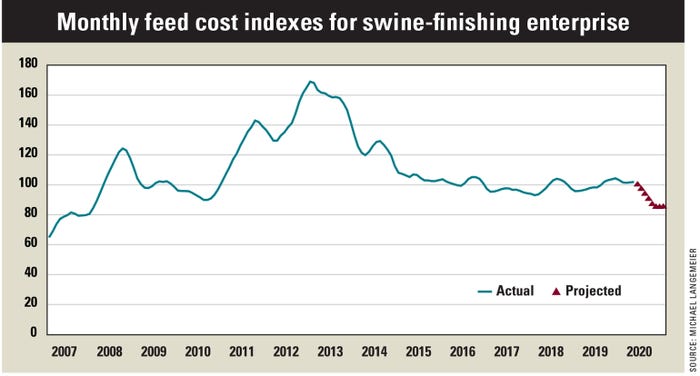May 29, 2020

Corn and soybean meal prices declined sharply from late January to mid-May. Feed prices are likely to be volatile for the rest of 2020. What’s the potential impact of different corn and soybean meal price projections on feed costs for swine finishing?
Assume you’re finishing an early-weaned pig. The ration consists of corn, soybean meal, dried distillers grain and supplements. Corn prices represent averages for Indiana as reported by USDA’s National Agricultural Statistics Service. Soybean meal and distillers grain prices were obtained from Feed Outlook, published monthly by USDA’s Economic Research Service. Information from Agricultural Prices, a monthly USDA-NASS publication, was used to compute supplement prices. Futures prices for corn and soybean meal in mid-May were used to project feed cost indexes through 2020. Feed cost indexes are reported on a closeout-month rather than a placement-month basis.
The average corn price since January 2007 is $4.52 per bushel, and the average soybean meal price is $351 per ton. Both corn and soybean prices are expected to remain considerably below these averages for the foreseeable future.
Indexes were used to examine variability in swine-finishing feed costs. The chart below presents monthly swine-finishing feed cost indexes from January 2007 to April 2020, and projections for the remainder of 2020. The latest full year of indexes, 2019, has an index of 100, so all indexes outside of this year are expressed in relative terms. Indexes since January 2007 have ranged from a low of 64.8 in January 2007 to a high of 169.0 in December 2012.

Feed cost indexes for the first quarter of 2020 averaged about 101.5. Indexes for the second quarter of 2020 are expected to range from 98 to 102. For the third and fourth quarters of 2020, indexes are expected to average 91 and 86, respectively. Feed cost indexes haven’t been below 90 since the middle of 2010. If feed price projections materialize, feed costs in 2020 will be about 9% below 2019.
Moving target
Feed costs are very sensitive to changes in corn and soybean meal prices. Regression analysis examined the relationship between hog-finishing costs and corn and soybean meal prices.
Each 10-cent increase in corn price increases feed cost by 44 cents per cwt, and each $10 increase in soybean meal increases feed cost by 32 cents per cwt. Feed cost per hundredweight in May was about $32. Using expected corn and soybean meal prices, feed cost is expected to range from $27 to $30 per cwt for the second half of 2020.
It’s also useful to examine feed cost per hundredweight for a range of corn and soybean meal prices. Let’s examine low and high price scenarios.
A corn price of $2.75 per bushel and a soybean price of $250 per ton would result in a feed cost of $24.15 per cwt. In contrast, a corn price of $3.75 and a soybean meal price of $350 per ton would result in a feed cost of $31.75 per cwt.
Again, with current projections, feed costs are expected to be about 9% below those experienced in 2019. Yet given uncertainty around corn and soybean meal prices, consider incorporating a relatively wide set of prices in swine-finishing feed cost budgets.
Langemeier is a Purdue University Extension agricultural economist and associate director of the Purdue University Center for Commercial Agriculture.
About the Author(s)
You May Also Like






